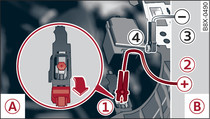-

- Fig. 1 Version 1) Engine compartment with battery: jump-starting with the battery of another vehicle: -A- – Discharged battery, -B- – Boosting battery
-

- Fig. 2 Version 2) Engine compartment with jump-start terminals: jump-starting with the battery of another vehicle: -A- – Discharged battery, -B- – Boosting battery
The two jump leads must be connected in the correct sequence.
The battery is located in the engine compartment or luggage compartment
(depending on the type of engine). Vehicles which have a battery
in the luggage compartment have a jump-start connection in the engine
compartment. The vehicle is always jump-started via the terminals
in the engine compartment. The earth point --- is always on the
vehicle's body.
The terminals are located at the front left of the engine compartment.
You may have to open a protective cover on the positive terminal
on your vehicle before connecting the cable.
Please note that the described method of connecting the leads is
meant for jump-starting your vehicle.
Connecting and disconnecting the jump leads
Connect one end of the red jump lead to the positive terminal
-1- Fig. 1
on your vehicle -A-
Caution!.
Connect the other end of the red jump lead to the positive terminal
-2- of the boosting battery -B-.
Connect one end of the black lead preferably to the earth point
or alternatively to the negative battery terminal -3- on the
vehicle providing assistance -B-.
Connect the other end of the black jump lead to the earth point
-4- on your vehicle -A-.
Position the jump leads in such a way that they cannot come
into contact with any moving parts in the engine compartment.
Starting the engine
Start the engine of the vehicle with the boosting battery and
let it run at idling speed.
Start the engine of the car with the discharged battery and
wait two or three minutes until the engine is running smoothly.
If the engine fails to start: do not operate the starter for
longer than 10 seconds. Wait for about 30 seconds and try again.
Switch on the blower and the rear window heating on the vehicle
which has been jump-started in order to offset excessive voltage
which may occur when disconnecting the leads. The headlights
must be switched off!
When the engines are running, disconnect the leads in exactly
the opposite sequence to that described on
Link.
Make sure that the leads cannot come into contact with any moving
parts in the engine compartment.
Switch off the blower and the rear window heating again.
Close any covers that were opened earlier on. Keep well clear
of all moving parts in the engine compartment.
WARNING!
- The non-insulated parts of the battery clamps must not be allowed to touch. The jump lead attached to the positive battery terminal must not touch metal parts of the vehicle: this can cause short circuiting.
- Do not lean over the batteries - risk of acid burns!
- The screw plugs on the battery cells must be screwed in firmly.
- Keep sparks, flame and lighted cigarettes away from batteries: the gases given off can cause an explosion.
- If jump-starting another vehicle, position the jump leads in such a way that they cannot come into contact with any moving parts in the engine compartment of the other vehicle.
Caution!
Please note that the above method of connecting the leads is
intended for jump-starting your vehicle. If jump-starting another
vehicle, you should not connect the negative lead (–) to the
negative terminal of the discharged battery, but directly to
the engine block or a solid metal part bolted to the engine
block. If the battery of the other vehicle does not have a gas
vent, there is a risk that a mixture of oxygen and hydrogen
gas can accumulate and cause an explosion.
Note
- The battery is vented to the outside to prevent gases entering the vehicle's interior.
- Connect the battery clamps so they have good metal-to-metal contact with the battery terminals.
